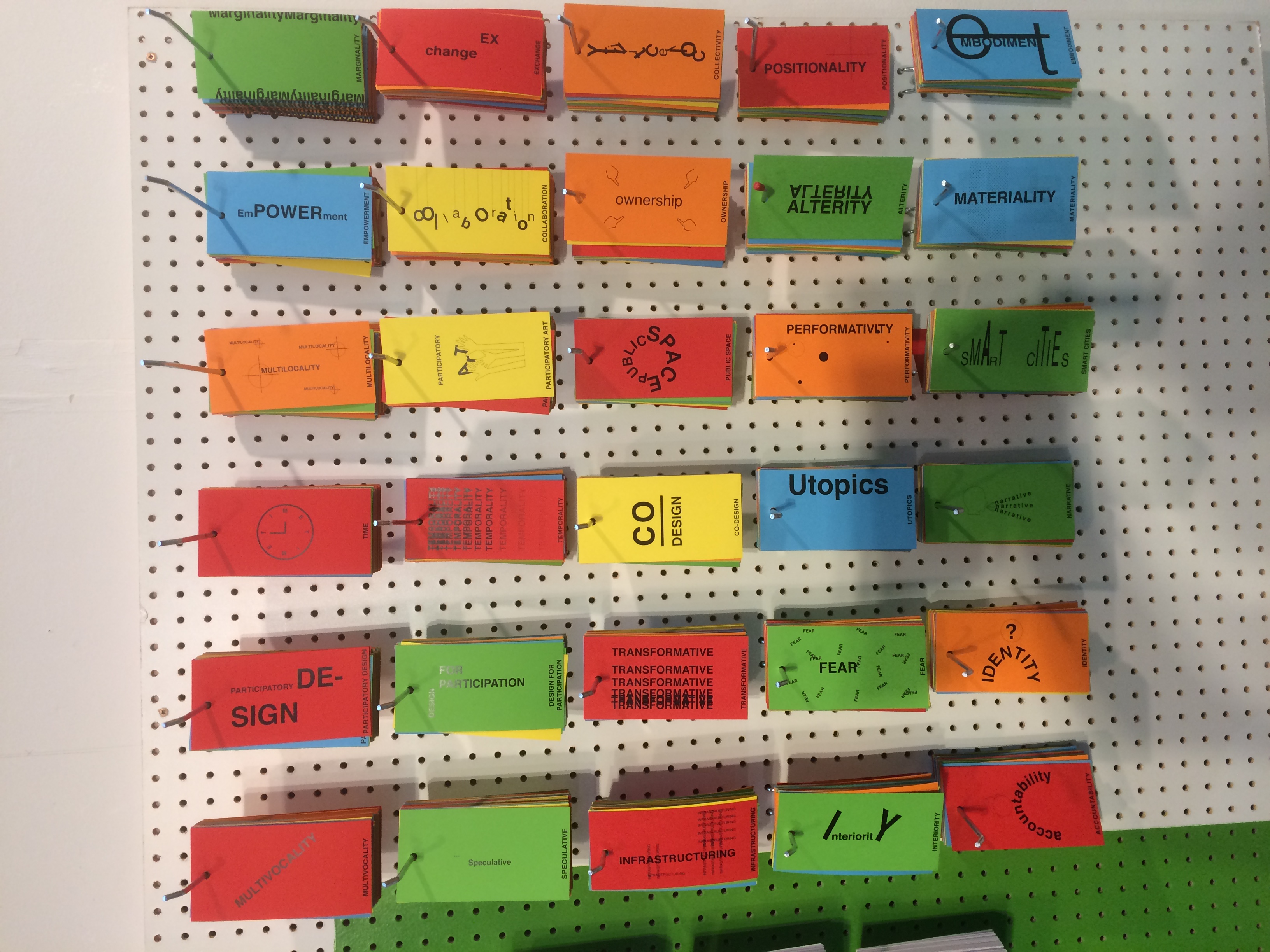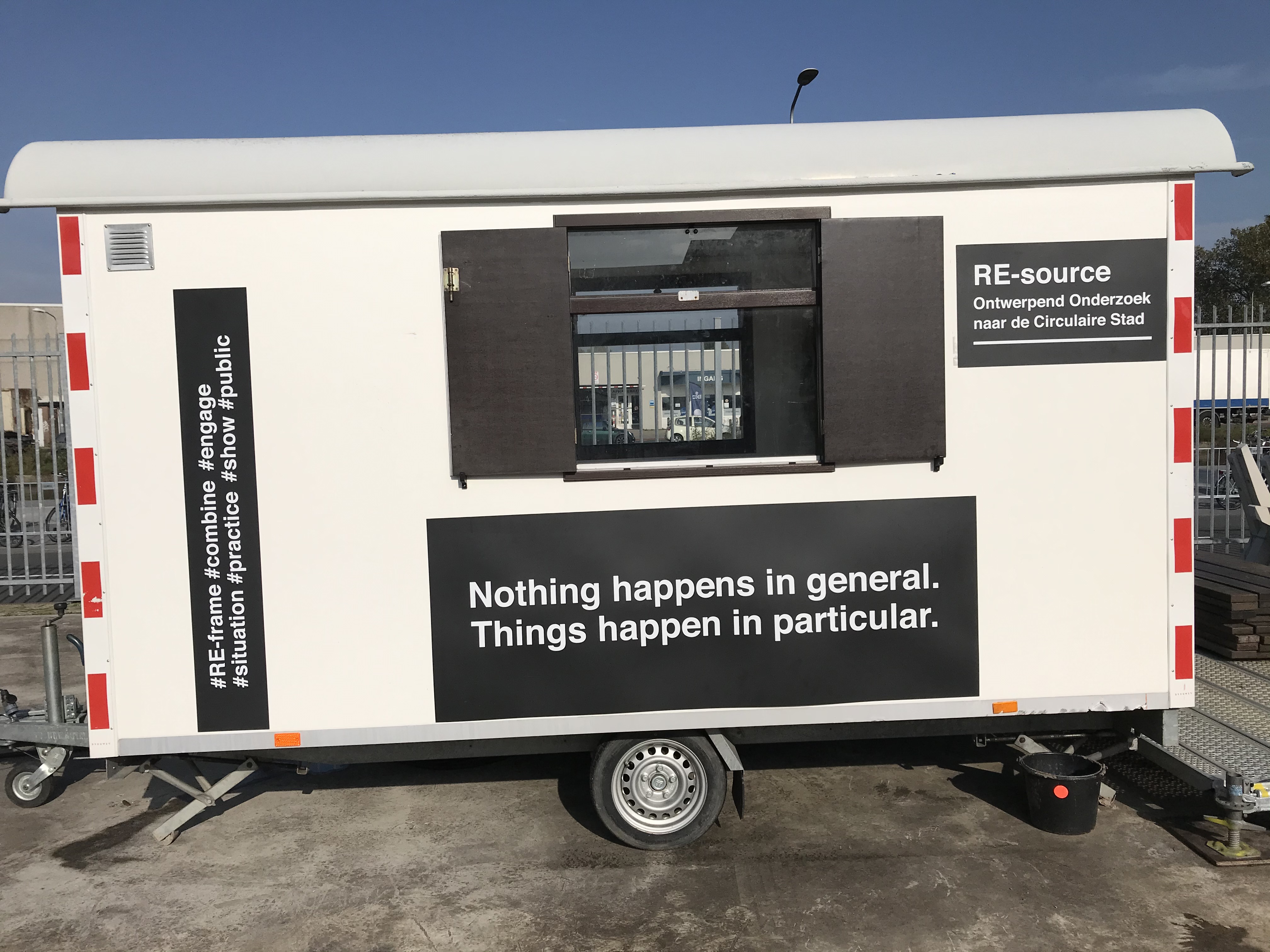'Lectorate Places and Traces, interview with David Hamers'
For 11 years, David Hamers directed the lectorate Stad en Land, later renamed Places and Traces. As of 1 July, he will leave the Design Academy Eindhoven with mixed feelings - of pride and concern - and focus again entirely on his work as senior researcher for PBL Netherlands Environmental Assessment Agency. “I hope most passionately that the spores we have spread from the lectorate will be nurtured.”
Interview with leaving professor David Hamers
Spores worth nurturing
‘We are looking for a Stad en Land professor’, the vacancy advertisement proclaimed in the summer of 2009. ‘Someone who researches every facet of the public space; from the urban core to the fringes. But most of all the candidate has a solid academic background and an affinity for research through design.’ Liesbeth van der Pol, head of Public Space and Chief Government Architect at the time and the late Hans van der Markt, department coordinator, sought an allround authority and found it in David Hamers.
Hamers, educated as a cultural scientist and economist at the University of Maastricht and with a doctorate from the philosophy department at the same university based on a study of American suburbs, fitted the requirements perfectly. Not unimportantly because of his book Niemandsland (No-man’s land) in which he describes his fascination for urban fringes. This had enormous appeal for Hans van der Markt. "I seem to remember that we talked mostly about ugly places in the city during my application interview.”
Pioneering
The lectorate started out as an extension of the Public Space department to stimulate research with the department. “Design research was still very diffuse in the early years. Incidentally, this was not by all means exclusive to the Design Academy. Everyone was still in the pioneering phase. Delft University of Technology was already creating a bit of a stir with design research. It quickly became evident that, as the Design Academy, we needed to provide counterbalance; something less targeted on supplying solutions through design, but more so in questioning existing solutions and posing new questions.”

Hamers uses we and in doing so refers to his own research team with an associate professor, design researchers and research associates (junior researchers), the lectorate Strategic Creativity with which he worked closely from 2011 until 2018 and the members of the so-called Knowledge Circle which he jointly established. The Knowledge Circle includes heads and tutors from the bachelor and master departments and representatives from the DAE policy department. “We all worked extremely hard together over the last few years on the development of a research community. This resulted in the development of the Lexicon of Design Research in which significant research terms are described with a ‘Design Academy’ signature, in words and images. We also set out our unique method in a manifesto, thinking-through-making. This method has proven to be invaluable. It has become a term that many other researchers have employed and have appropriated as their own. This allowed us to create our own place in the field of research.”
"Employing thinking-through-making allowed us to create our own place in the field of research"
From Stad en Land to Places and Traces
In 2011 the lectorate received an invitation to join the European research project TRADERS (Training Art and Design Researchers in Participation for Public Space); a four-year research project with 6 European universities, art and design academies, 6 companies operating in Europe and 6 PhD researchers. This was the trigger for no longer only connecting the lectorate to the Public Space department but to the entire academy and to give it a new name: Places and Traces. “No dichotomy, but a playful use of associated words that, through the twist, acquired a new meaning and consequently were able to get things moving. Just one of the things that I learned from Hans van der Markt.”
The lectorate focuses on the role of design in understanding and transforming public spaces; the role of people, materials, information or a combination of these.

Following the TRADERS project came other research projects, sometimes targeted on products, like the Mycelium project which researched the development of 100% natural products based on fungi, but also research focused on the design of innovative strategies or policy. Examples of this are the Innovation Programme Mobiele Stad, a study of sustainable mobility in urban regions, and the friends project with the water authority Waterschap De Dommel, about new approaches to water surpluses and shortages. All the projects involved Design Academy alumni as design researchers or research associates. “I can safely say that after 11 years we have educated great students who, especially because of their openness to look further and to uncover the question behind the question, have staked their claim of a unique position in research projects.”
Proud
“I am perhaps most proud of the RE-source project, not unimportantly because the project won a Dutch Design Award last year in the design research category. In this project we researched the circular economy in an urban environment. Vast amounts of material have to be moved and stored in a city. Usually this is organised from an engineer’s or economist’s vantage point. In RE-source we looked at existing situations from a designer’s perspective and investigated how we could shift and link flows, giving them new meaning and destinations. The research associate Paul Slot, for instance, studied the repair of city benches. You can store benches in a closed depot, but you can also make them available for use during the repair, spread around a field for a bootcamp for example. This is just one of the many examples from the project of how you can take a fresh look at material flows. Incidentally it is more than possible that this has created a new profession for designers: the location scout."

The project enjoyed many spinoffs. Studio Ester van de Wiel, The municipality of Rotterdam and Museum Boijmans van Beuningen have embarked on a new research project. It was also announced this week that RE-source is to be included in the Boijmans collection; “exceptional for a research project to become part of a museum collection, and crowning glory for our work.”
Substrate and growth
People say you should quit when you reach your high point, but all the same this is not entirely how this feels for David. It is apparent that his decision to leave the academy causes him discomfort. “We have achieved so much over the last 11 years. In my modest appointment of less than one day a week with a team comprising only part-timers who, for each new research project, had to link temporarily with external financing, we presented high-calibre research projects, books, articles, films, debates and exhibitions. This certainly took its toll over the last few years, because we had to build on an unstable base. I am not convinced that the foundations are solid enough for further growth. I see a parallel with mycelium: the structure of the fungi and its tentacles spreading everywhere - and think this is a fitting metaphor for the lectorate. With countless partners we planted our spores in society, education and the research field. But fungi need a good substrate. Unfortunately, this is sensitive at the Design Academy Eindhoven. I hope most passionately that future lecturers are able to seek out the spores, to further and extend them, so that the fungi can continue to grow."
By Daniëlle Arets, journalist, moderator, Knowledge Transfer Officer and former Associate Lector, Readership Strategic Creativity.
In addition to the larger, longer term research projects listed below, associate professor Paolo Patelli has worked on many smaller projects, resulting in a series of publications, workshops, lectures and exhibitions. Paolo will remain involved with the Design Academy Eindhoven as a researcher after the departure of professor David Hamers. The same applies to project manager Anne Vader and research coordinator Nienke Vording.
TRADERS: Training Art and Design Researchers in Participation for Public Space:
• 2013-2017
• How can design researchers involve stakeholders in public space projects?
• Design researcher / PhD candidate: Naomi Bueno de Mesquita
• With LUCA School of Arts, HDK/University of Gothenburg, Royal College of Art, Chalmers University of Technology, KU Leuven, Z33, KOMPAN, STBY, Commonplace Digital Ltd., City of Gothenburg. Funded by EU/FP7/Marie Curie/Multi ITN
• Main publication: Trading Places: Practices of Public Participation in Art and Design Research (2017)
Mycelium-based Materials for Product Design:
• 2016-2019
• How can we improve and standardise the technical and experiential qualities of naturally grown, mycelium materials?
• Design researcher: Maurizio Montalti
• With Utrecht University, TU Delft, MOGU, CNC Exotic Mushrooms, Zwethlande, Tresor, Mediamatic. Funded by NWO/TTW
• Exhibition Fungal Curiosities at DAE’s Graduation Show (2017)
Platform Smart Cities & Citizens:
• 2017-2019
• How can smart city approaches (ict, data) help create better urban environments?
• David Hamers
• With Hogeschool Saxion, Hogeschool Utrecht, Hogeschool van Amsterdam, Hogeschool Van Hall Larenstein, ClickNL, Topteam High Tech Systems en Materialen, SBRCURnet, CROW-KpVV, Planbureau voor de Leefomgeving, TNO, Platform31. Funded by SIA
• Main publication: Praktijkboek Smart Cities & Citizens (2019)
Re-source: Participation in Reframing Residual Materials in Design Theory, Design Practice and Design Education:
• 2017-2020
• How can design research help re-frame and re-make flows of residual materials (waste) into valuable resources?
• Design researcher: Ester van de Wiel; research associates: Jos Klarenbeek, Thom Bindels, Simone Post, Paul Slot, Manon van Hoeckel
• With Vrije Universiteit Amsterdam, Studio Ester van de Wiel, municipality of Rotterdam. Funded by NWO/SIA/Smart Culture and Studio Ester van de Wiel
• Main publication: RE-source: ontwerpend onderzoek naar de circulaire stad (2019)
Innovatieprogramma Mobiele Stad:
• 2017-2020
• How can experiments help integrate innovative approaches to spatial, technological and mobility issues in the urban region?
• Research associate: Bennie Meek
• With Universiteit Twente, Universiteit van Amsterdam, Radboud Universiteit Nijmegen, Bureau UUM. Funded by Ministerie van Infrastructuur en Milieu, Ministerie van Binnenlandse Zaken en Koninkrijksrelaties, provincies Gelderland, Noord-Brabant, Noord-Holland, Utrecht, Zuid-Holland, Transumo Footprint
• Publications: Ruimte maken: denkgereedschap voor een autoluw World Food Center (2019); Empathische reis Zaanse Schans: belevingsgereedschap voor de verbetering van de reiservaring van een toerist in het openbaar vervoer (2020); Serious game Kennisas-ontwikkeling Tilburg: gamificatie van een tool voor scenariovorming gericht op het ontwikkelen van stationsgebied Tilburg Universiteit (de ‘Kennisknoop’) (2020)
Vriendenprojecten Waterschap De Dommel:
• 2019: Water voor stadsbomen / boomrooster van maaisel
• Hoe kunnen we wateroverlast in de stad tegengaan én het materiaal dat we daarvoor gebruiken circulair maken?
• Research associate: Lucas Zoutendijk
• With Studio 1:1
• Exhibition of prototype at Embassy of Water (Dutch Design Week 2019)
• 2020: Droogteschap
• Hoe ziet een toekomstig Waterschap eruit als dit zich niet alleen op waterbeheer maar ook op droogtebeheer richt?
• Research associate: Lucas Zoutendijk
• With Studio 1:1
• Planned exhibition of scenario (Dutch Design Week 2020)